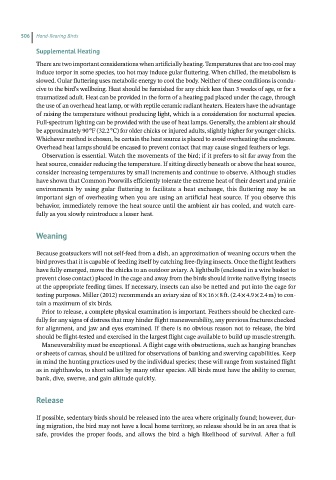Page 509 - Hand rearing birds second
P. 509
506 Hand-Rearing Birds
Supplemental Heating
There are two important considerations when artificially heating. Temperatures that are too cool may
induce torpor in some species, too hot may induce gular fluttering. When chilled, the metabolism is
slowed. Gular fluttering uses metabolic energy to cool the body. Neither of these conditions is condu-
cive to the bird’s wellbeing. Heat should be furnished for any chick less than 3 weeks of age, or for a
traumatized adult. Heat can be provided in the form of a heating pad placed under the cage, through
the use of an overhead heat lamp, or with reptile ceramic radiant heaters. Heaters have the advantage
of raising the temperature without producing light, which is a consideration for nocturnal species.
Full‐spectrum lighting can be provided with the use of heat lamps. Generally, the ambient air should
be approximately 90 °F (32.2 °C) for older chicks or injured adults, slightly higher for younger chicks.
Whichever method is chosen, be certain the heat source is placed to avoid overheating the enclosure.
Overhead heat lamps should be encased to prevent contact that may cause singed feathers or legs.
Observation is essential. Watch the movements of the bird; if it prefers to sit far away from the
heat source, consider reducing the temperature. If sitting directly beneath or above the heat source,
consider increasing temperatures by small increments and continue to observe. Although studies
have shown that Common Poorwills efficiently tolerate the extreme heat of their desert and prairie
environments by using gular fluttering to facilitate a heat exchange, this fluttering may be an
important sign of overheating when you are using an artificial heat source. If you observe this
behavior, immediately remove the heat source until the ambient air has cooled, and watch care-
fully as you slowly reintroduce a lesser heat.
Weaning
Because goatsuckers will not self‐feed from a dish, an approximation of weaning occurs when the
bird proves that it is capable of feeding itself by catching free‐flying insects. Once the flight feathers
have fully emerged, move the chicks to an outdoor aviary. A lightbulb (enclosed in a wire basket to
prevent close contact) placed in the cage and away from the birds should invite native flying insects
at the appropriate feeding times. If necessary, insects can also be netted and put into the cage for
testing purposes. Miller (2012) recommends an aviary size of 8 × 16 × 8 ft. (2.4 × 4.9 × 2.4 m) to con-
tain a maximum of six birds.
Prior to release, a complete physical examination is important. Feathers should be checked care-
fully for any signs of distress that may hinder flight maneuverability, any previous fractures checked
for alignment, and jaw and eyes examined. If there is no obvious reason not to release, the bird
should be flight‐tested and exercised in the largest flight cage available to build up muscle strength.
Maneuverability must be exceptional. A flight cage with obstructions, such as hanging branches
or sheets of canvas, should be utilized for observations of banking and swerving capabilities. Keep
in mind the hunting practices used by the individual species; these will range from sustained flight
as in nighthawks, to short sallies by many other species. All birds must have the ability to corner,
bank, dive, swerve, and gain altitude quickly.
Release
If possible, sedentary birds should be released into the area where originally found; however, dur-
ing migration, the bird may not have a local home territory, so release should be in an area that is
safe, provides the proper foods, and allows the bird a high likelihood of survival. After a full

